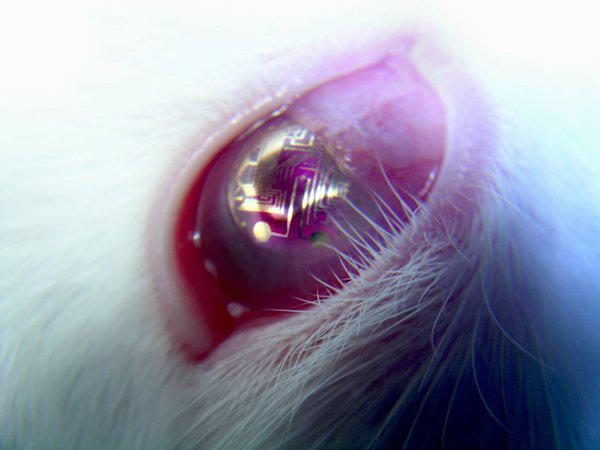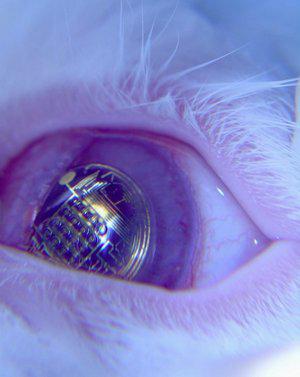Established contact lenses with chips inside
 Bashny.Net
Bashny.Net
University of Washington News and Information
Engineers and scientists from the University of Washington (University of Washington), headed by Professor Babak Parviz (Babak Parviz) for the first time combined the chips and miniature light sources with a biocompatible flexible and transparent material, creating a contact lens that can take into the field of view of the owner of various images.

We can recall every "terrible" bio-robots of science fiction films, which when you look at the surrounding objects seen crosses sights or maps, or characteristics of objects. However, the developers see it as a novelty a few more peaceful unit.
These contact lenses can help improve vision impaired people or create a virtual driver before the eyes of the dashboard, or provide surfing the Internet on the go, or to immerse players in a virtual world without restriction in movement.
So far, however, the possibility of lens-chip rather modest, but the first prototypes - an important step towards the future outlined above, the transition from the display in the "glasses" to displays in contact lenses. Authors of new items only wanted to show that the technology is efficient and that such lenses are safe. On the technology, by the way, I must say too much.

Creating such a device was not easy because of biologically compatible materials conventionally used in contact lenses, require delicate handling, are not compatible with conventional technologies create circuits (which use high temperatures, chemicals and so on).
Because researchers have created a metallic conductor thickness of a few nanometers in diameter and LEDs with only a third of a millimeter. Set these parts formed a kind of powder, where each particle has a specific shape and unique edges, allows you to connect a "complimentary" a piece of the future schemes.
This powder authors of the new technology spread on the surface of the plastic where the intended scheme going by itself, due to capillary forces between microscopic components.
Parviz says that around the pupil and iris in the eyeball has a lot of open area, where you could place various devices out of sight of the person.
Authors unusual lenses intend to further add to her scheme for wireless two-way communication. And although the introduction of such a device in a full translucent screen - far, the version with a relatively small number of pixels may be ready in the near future.
We add that such lenses may one day be useful when creating a so-called mixed reality.

Source:
Engineers and scientists from the University of Washington (University of Washington), headed by Professor Babak Parviz (Babak Parviz) for the first time combined the chips and miniature light sources with a biocompatible flexible and transparent material, creating a contact lens that can take into the field of view of the owner of various images.

We can recall every "terrible" bio-robots of science fiction films, which when you look at the surrounding objects seen crosses sights or maps, or characteristics of objects. However, the developers see it as a novelty a few more peaceful unit.
These contact lenses can help improve vision impaired people or create a virtual driver before the eyes of the dashboard, or provide surfing the Internet on the go, or to immerse players in a virtual world without restriction in movement.
So far, however, the possibility of lens-chip rather modest, but the first prototypes - an important step towards the future outlined above, the transition from the display in the "glasses" to displays in contact lenses. Authors of new items only wanted to show that the technology is efficient and that such lenses are safe. On the technology, by the way, I must say too much.

Creating such a device was not easy because of biologically compatible materials conventionally used in contact lenses, require delicate handling, are not compatible with conventional technologies create circuits (which use high temperatures, chemicals and so on).
Because researchers have created a metallic conductor thickness of a few nanometers in diameter and LEDs with only a third of a millimeter. Set these parts formed a kind of powder, where each particle has a specific shape and unique edges, allows you to connect a "complimentary" a piece of the future schemes.
This powder authors of the new technology spread on the surface of the plastic where the intended scheme going by itself, due to capillary forces between microscopic components.
Parviz says that around the pupil and iris in the eyeball has a lot of open area, where you could place various devices out of sight of the person.
Authors unusual lenses intend to further add to her scheme for wireless two-way communication. And although the introduction of such a device in a full translucent screen - far, the version with a relatively small number of pixels may be ready in the near future.
We add that such lenses may one day be useful when creating a so-called mixed reality.

Source:
Tags
See also
Engineers offered contact lenses with antimicrobial coating
To replace Google Glass will come "smart" contact lenses
The contact lens case all-in-one
Avoid these 5 dangerous mistakes with contact lenses
The most unusual contact lenses
Developed lens with built-in displays
Part 4.1 restored sight. From points to the excimer laser
The 3D-printer printed the contact lenses with built-in OLED-display
Invented the bionic lens-binoculars
















